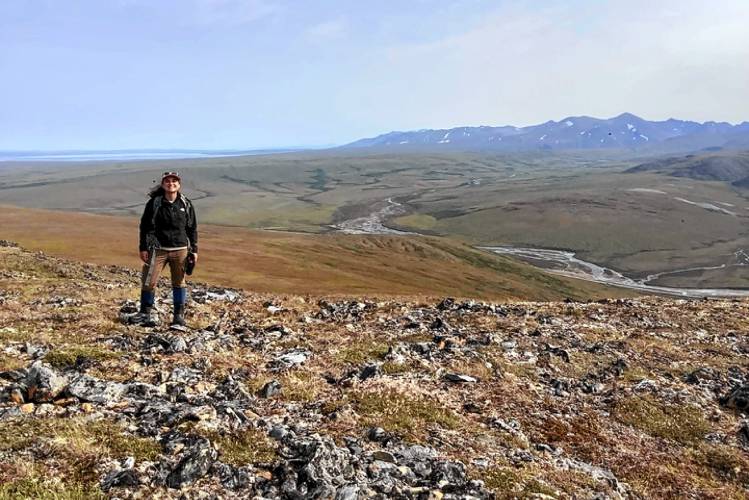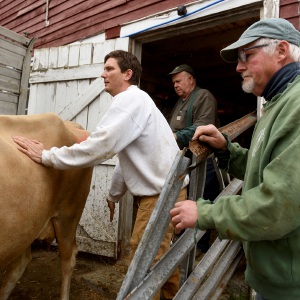New Dartmouth research shows how permafrost shapes Arctic rivers and what that means for climate change

Joanmarie Del Vecchio, then a Neukom Postdoctoral Fellow, leads a hike in Alaska to study why Arctic watersheds have less river area. (Courtesy Dartmouth College) Courtesy Dartmouth College
| Published: 02-27-2024 5:01 PM |
Thick, frozen soil — or permafrost — is the driving force that shapes Arctic rivers, according to new research from Dartmouth. And the lead researcher says that’s key to understanding how climate change might affect, and be affected by, carbon stored in that frozen soil.
Joanmarie Del Vecchio, who led the study when she was at Dartmouth as a postdoctoral fellow, got the idea when she was looking over a landscape in Western Alaska during fieldwork in the summer of 2019.
“I said, ‘Gosh, it doesn’t look like there are a lot of rivers out here,’ ” she said.
From that simple observation, Del Vecchio developed a hypothesis that permafrost landscapes are less likely to get carved up by rivers than landscapes in temperate climates.
Her team sought to understand whether the Arctic had fewer rivers than warmer places, and if other factors, like the history of glaciers in the area or the amount of precipitation a place gets, influenced that more than the frozen state of the ground.
They found that compared to watersheds in temperate places, those that have permafrost have about 20% less of their landscape occupied by channels for water — despite differences in their topography, glacial history, precipitation, and other factors.
Basically, Del Vecchio said, if a place is warmer, it has more channels for water. And that matters when thinking about the effects of climate change on the Arctic.
“We haven’t had some of this data until recently, and that has meant people have only been able to speculate about what might happen if the permafrost thaws,” she said.
Article continues after...
Yesterday's Most Read Articles
 Herd departs Hartford’s last remaining dairy farm
Herd departs Hartford’s last remaining dairy farm
 At Dartmouth, hundreds protest ongoing war in Gaza and express support for academic freedom
At Dartmouth, hundreds protest ongoing war in Gaza and express support for academic freedom
 Claremont removes former police officer accused of threats from city committees
Claremont removes former police officer accused of threats from city committees
 Over Easy: ‘A breakfast without a newspaper is a horse without a saddle’
Over Easy: ‘A breakfast without a newspaper is a horse without a saddle’
There was an opposite hypothesis, which theorized that in a frozen landscape water can’t go underground, so it might make more channels out of necessity. That would mean there were more water channels in the Arctic than in warmer places, and they might shrink when the permafrost thaws.
But Del Vecchio’s study shows that as the Arctic gets warmer, water channels could grow.
“We propose now that as it gets warmer, that carving process turns up in volume as you get more and more thaw over time,” she said.
As landscapes change, they are either smoothed out or carved up, Del Vecchio said. If in the Arctic the landscape was smoothed out, that would bury carbon in the ground, locking it away and keeping it from heating up the atmosphere.
But data show as it gets warmer, the Arctic will be more subjected to carving and erosion, Del Vecchio said. That has big implications for people who live downstream of rivers, whose communities could also be more affected by flooding as sediment is churned up and causes water to move around more.
The carving of new water channels could also expose the carbon stored in soils.
“When you start eroding through soil that has carbon in it, that’s when the microbes can get to it and consume the carbon in the soil and burp out methane and carbon dioxide,” she said. “That’s a problem, because the more it happens, the more it’s going to warm, and the more we might carve into the soil carbon.”
That feedback loop could accelerate climate change. For every degree Celsius of warming, the researchers say waterways carving up thawing soil could release as much carbon as 35 million cars emit in one year.
Understanding how permafrost landscapes could release carbon could be an important factor in setting global carbon budgets, and setting climate policy in the United States, Del Vecchio said.
And the data she used for her study is widely available: Anyone with an internet connection can observe the Arctic and contribute to the understanding of how permafrost landscapes work, she said.
“We have all of this data to study this landscape, but it’s coming just in the nick of time,” she said. “We need to know what happens to the permafrost so that we can set reasonable and aggressive enough goals for reducing greenhouse gas emissions.”
These articles are being shared by partners in The Granite State News Collaborative. For more information visit collaborativenh.org.

 JAG Productions announces closure, citing ‘crisis facing the arts’
JAG Productions announces closure, citing ‘crisis facing the arts’
